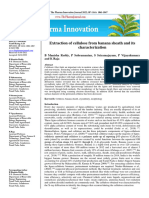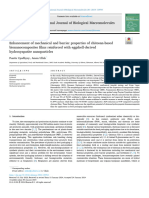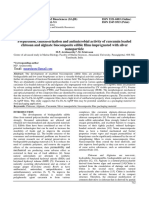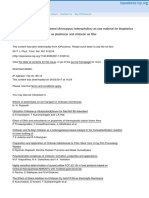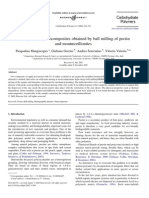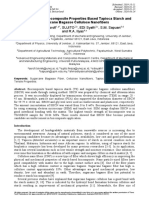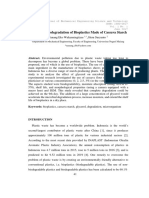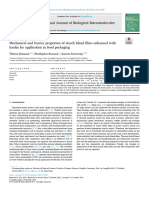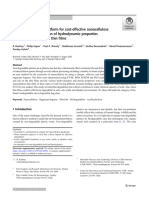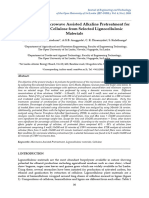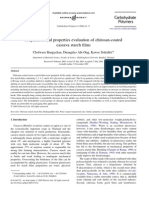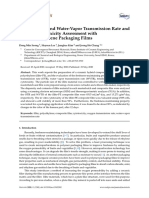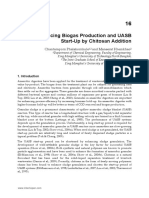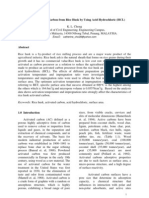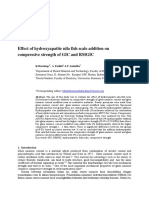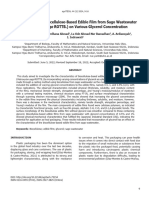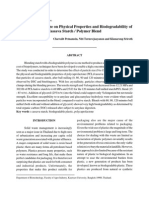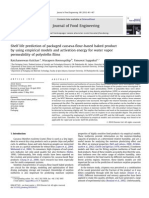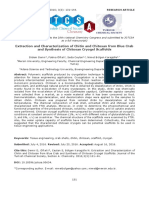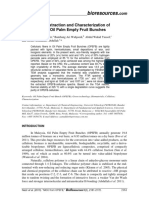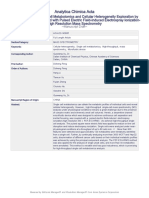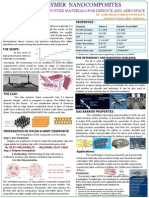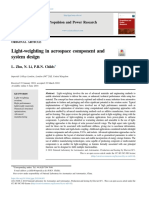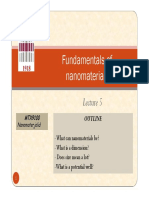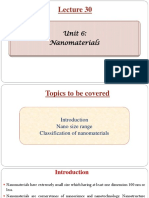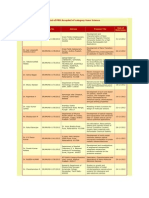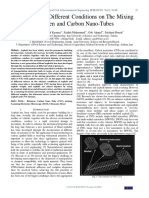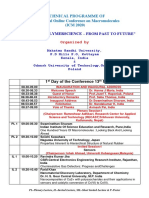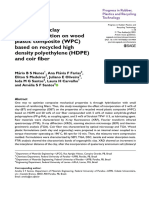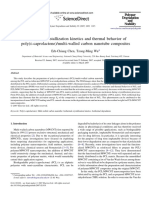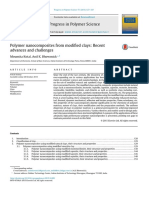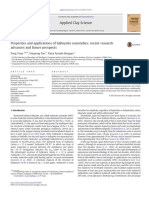Jurnal Chitosan
Jurnal Chitosan
Uploaded by
Pesbuk KlonenganCopyright:
Available Formats
Jurnal Chitosan
Jurnal Chitosan
Uploaded by
Pesbuk KlonenganOriginal Title
Copyright
Available Formats
Share this document
Did you find this document useful?
Is this content inappropriate?
Copyright:
Available Formats
Jurnal Chitosan
Jurnal Chitosan
Uploaded by
Pesbuk KlonenganCopyright:
Available Formats
International Journal of Technology (2010) 1: 6573 ISSN 20869614 IJTech 2010
PREPARATION AND CHARACTERIZATION OF CHITOSAN/MONTMORILLONITE (MMT) NANOCOMPOSITE SYSTEMS
Hery Haerudin1, Andika W. Pramono2, Dona Sulistia Kusuma1*, Aisyiyah Jenie1, Nicolas H. Voelcker3, Christopher Gibson3
Research Center for Chemistry, Indonesian Institute of Sciences, 2 Kawasan PUSPIPTEK, Serpong, Tangerang 15314, Indonesia Research Center for Metallurgy, Indonesian Institute of Sciences, 3 Kawasan PUSPIPTEK, Serpong, Tangerang 15314, Indonesia
School of Chemistry, Physics and Earth Sciences, Flinders University of South Australia, GPO Box 2100, Bedford Park, South Australia, 5042, Australia
(Received: June 2010 / Revised: June 2010 / Accepted: July 2010)
ABSTRACT A natural- based nanocomposite film consisting of chitosan, montmorillonite (MMT) and cashew nut shell liquid (CNSL) was synthesized. The nanocomposite was prepared by mixing a suspension of clay particles (filler, MMT) with a solution containing chitosan as the macroscopic polymer matrix. In this study, it was proposed that non-ionic long-chain alkyl molecules with possible interactions with the amine group of chitosan could be used as a plasticizer. As a natu-ral source for these compounds, an extract of CNSL was used. A series of chitosan/MMT com-posite samples containing two different clay contents and a sample with an additional CNSL were prepared. FTIR spectroscopy of the nanocomposite films indicated that, by addition of CNSL, amide groups of the chitosan are probably less attached and have more space for vibra-tion. CNSL seems to provide intermolecular spaces between the chitosan
molecules. Atomic force microscopy (AFM) analysis showed that the composite contained particles measuring 100 nm or less, which confirmed that the nanocomposite had been successfully produced by this method. Addition of CNSL as plasticizer improved the tensile strength by 10% and the elastic modulus by almost 18%. Cell growth was observed on all the nanocomposite samples studied.
Keywords: Chitosan; CNSL; Montmorillonite (MMT); Nanocomposite
1. INTRODUCTION The use of biopolymers as components of composites for packaging materials is a very popular topic for current studies. Studies regarding the improvement of composite properties such as brittleness, low heat distortion temperature, gas permeability, etc. for a wide range of applications are very much of interest. Additionally, the development of biobased nanocomposites are carried out with the intention of providing physical protection for food, improving food integri-ty, and preventing contamination from microbes and fungi (Rhim et al., 2006). The use of bio-based nanocomposites for packaging material has been reviewed (Akbari et al., 2007). Chitosan as a biopolymer is also widely studied for development of a new composite material with montmorillonite (MMT) clay.
* Corresponding authors email: d_sulistia@yahoo.com, Tel. +62217560929, Fax. +62217650549
66
Preparation and Characterization of Chitosan/Montmorillonite (MMT) Nanocomposite Systems
Various experiments including the modification of MMT properties by converting the MMT into organo-montmorillonite (OMMT) prior to the nanocomposite preparation (Wang et al., 2008), as well as the variation of MMT concentration and dimensions to enhance the properties of the chitosan/MMT composite were studied (Tang et al., 2009). Thorough studies on the interaction of small molecules such as glycerol, as a plasticizer, with chitosan in chitosan film were also conducted (Garrido et al., 2007). Regarding the limited water- resistant and mechanical properties of original biopolymers, studies on the improvement of those properties by including hydrophobic material into the biopolymer composite (Liu et al., 2007), or by the addition of other small molecules to enhance hydrophobicity (Rivero et al., 2009) or plasticity (Suyatma, et al., 2005) were carried out. Since application of the chitosan composite as a packaging material for food is strongly considered, especially due to its antimicrobial activity, most studies of the chitosan/clay nanocomposite have also included antimicrobial activity testing (Dutta et al., 2009). It is known that the properties of the polymer/clay composite are strongly affected by the addition of surfactant(s) into the composite. On those systems, the typical molecules are longchain alkyl quaternary ammonium chlorides (Xie et al., 2003), which are easily incorporated into the clay structure. Large molecule additions, except the use of long-chain alkyl quaternary amines or polyglycol (Bajdik et al., 2009), to manipulate the composite properties are seldom studied. In the present study, it was proposed that non-ionic long-chain alkyl molecules with possible interactions with the amine group of chitosan could be used as a plasticizer. As a natural source for these compounds, an extract of cashew nut shell (cashew nut shell liquidCNSL) was used. A series of chitosan/MMT composite samples containing two different clay contents and a sample with an additional CNSL were prepared. CNSL is known as a source for cardol, carda-nol, and anacardic acid, and is a phenolic compound with a long-chain alkyl group. A typical solvent-extracted CNSL contains anacardic acid (60-65%), cardol (15-20%), cardanol (10%) and traces of methylcardol (Kumar et al., 2002). Addition of CNSL as a source of relatively large molecules into the composite was intended also to improve the hydrophobicity as well as the mechanical properties of resulting composites.
2. EXPERIMENTAL 2.1. Materials Montmorillonite (MMT) employed in this study was K10 montmorillonite from Sigma-Aldrich. It is well known as having a CEC of 70-100 meq/100 g. Chitosan purchased from SigmaAldrich (Cat. No. C3646) had a degree of deacetylation of 85% minimum. Commercial
cetyltrimethyl ammonium bromide (CTAB) from E-Merck (Cat. No. 1.02342) was employed for this study. Cashew Nut Shell Liquid was extracted from cashew nut shells originating from Sumba Island, Indonesia. Prior to its use for composite preparation, chitosan was pre-treated in a basic solution of 10% NaOH. The extraction procedure for CNSL was as follows. Fresh redistilled n-hexane was added to the cashew nut shell in a round glass flask. Extraction was carried out by refluxing 100 g cashew nut shell in 250 ml of n-hexane for 2 hours; this procedure was followed by filtration and evaporation of n-hexane.
2.2. Preparation of na-montmorillonite(Na-MMT) and organo-montmorillonite (OMMT) The OMMT was prepared by cation exchange between Na-MMT galleries and CTAB in an aqueous solution. MMT (2 g) was dispersed using a stirrer in distilled water to obtain clay suspension, and allowed to stand for 24 hours after vigorous stirring for 30 minutes. CTAB (2 g) was dissolved in distilled water, and then dropped slowly into the MMT suspension at 85C under stirring. After stirring for 4 hours, the product was washed several times with distilled
Haerudin et al.
67
water and filtered to ensure the complete removal of bromide ions, which were detected with AgNO3 until no AgBr precipitate was found. The product was dried at 85C to yield OMMT.
2.3. Preparation of chitosan/montmorillonite composite The chitosan solution was prepared using a 1% acetic acid solution. 4 g chitosan was dissolved in 100 ml acetic acid solution (1%) and stirred for 4 hours to obtain a homogeneous mixture. A 2% clay suspension in acetic acid solution (1%) was also prepared. The suspension was added into the resulting gel such that a 1% and 3% MMT content in the mixture was obtained. The mixture was stirred at 50C for 2 days to obtain a homogeneous chitosan/MMT suspension. This procedure was carried out using K10 montmorillonite (Sigma-Aldrich), Na-exchanged K10 and CTAB exchanged K10. For samples containing CNSL, a solution of 25 mg CNSL in 100 ml ethanol was prepared separately. The CNSL solution was added accordingly into the chitosan/MMT mixture after a rigorous 2 days of mixing, and then a final 1% CNSL content was obtained.
2.4. Characterization 2.4.1. Infrared (IR) spectroscopy All IR spectra were obtained using a Nicolet Avatar 370MCT (Thermo Electron Corporation, USA) equipped with a standard transmission accessory. Spectra of the composite films were recorded and analyzed using OMNIC version 7.0 software, in the range of 650-4000 cm1 at a resolution of 1 cm1; the background was taken using an original chitosan powder. IR of the composite film was performed in transmission mode with crushed powders in KBr discs in the range of 6504000 cm1 at a resolution of 1 cm1. Tapping mode AFM was performed on a Multimode Nanoscope IV microscope (Veeco Corporation, USA). Commercial Si cantilevers (FESP, Veeco Corporation, USA) were used for all experiments. The images were processed and analyzed using the Nanoscope 5.31r1 software (Veeco Corporation, USA).
2.4.2. Differential scanning calorimetry (DSC) In the present work, DSC 2920 (TA Instruments) was used for the measurement. The instrumental cell constant and temperature calibration were performed using indium. Chitosan/MMT samples were analyzed under continuous heating conditions (10C min-1) between room temperature and 200C. 8-10 0.1 mg of sample was weighed into a standard
aluminium pan and placed onto the DSC cell platform.
2.4.3. Mechanical properties The mechanical properties of chitosan/ MMT nanocomposites were tested using a Universal Testing Machine, Orientec Co. Ltd., Model UCT, 5-T. The specimens were prepared according to ISO 527-2. All specimens were tested using a crosshead speed of 1 mm/min.
2.4.4. Cell growth test 1 cm2 membranes were transferred to wells of a 12 well Iwaki tissue culture plate (Cat. No. 3815-012). Membranes were seeded with HEK 293 cells at density 105 cells/cm2 (3.85x105 cells per well in a 2 mL volume) in DMEM (Invitrogen) +10% FCS (JRH) + 2 mM Lglutamine + 100 U/ mL penicillin 100ug/mL streptomycin (Invitrogen). HEK 293 cells were grown in the presence of the membranes for 20 hours at 37C 5% CO2. At 20 hours media was removed and replaced with 2 ng/mL Hoescht 33342 (Sigma) stain in complete media and incubated at 37C 5% CO2 for 0.5 hours. Staining was visualized under appropriate fluorescent excitation/emission conditions for Hoescht stain. The photographs were taken with a 20xobjective on a Leica laborluxD fluorescent scope.
68
Preparation and Characterization of Chitosan/Montmorillonite (MMT) Nanocomposite Systems
3. RESULTS AND DISCUSSION Table 1 as shown below lists the samples used for the studies. Each sample consists of 3% clay Clay type CNSL or its modified one. CNSL was added as a solution in ethanol; 1% w/w of the chitosan was used for film preparation. Table 1 List of samples tested for the studies
Addition K10 K10-CTAB K10-CN K10-CTAB-CN Untreated Organic clay Untreated Organic clay No No Yes Yes
Figure 1 Transmission FTIR spectra of (a) pure chitosan (CS) film; (b) CS/3% K10; (c) CS/3% K10-CN; (d) CS/3% K10-CTAB; and (e) CS/3% K10-CTAB-CN composites
Generally, the amide bands are shifted to the higher wave number by addition of the CNSL. By addition of CNSL, amide groups of the chitosan are probably less attached and have more space for vibration. CNSL seems to provide intermolecular spaces between the chitosan molecules. This should create a higher plasticity in the resulting material. It should be noted that the C-O stretching band around 1160 cm-1 remained undisturbed by the addition of CNSL.
It should be noted that, at the pre-processing stage, raw data sets are passed through a filter that generates output in the form of more data which can be further used for actual comparative analysis between species. It is evident from Figure 2 that the dataset contains characters other than pure nucleotide bases. These illegal characters are removed by application of a cleansing filter. At first instance it is worth noting that analysis should be made with original data values; any garbage collection may lead to detritions of results.
Haerudin et al.
69
(a)
(b)
Figure 2 Morphology analysis of longitudinal section of CS/K10-CTAB using AFM; (a) Particle horizontal size of 103 nm (b) Particle horizontal size of 139 nm 3.1. Infrared spectroscopy FTIR analyses of the composite films were performed to study the structural changes caused by modification of the clay component prior to the preparation of the composite. The IR spectra were taken by transmission as well as the DRIFT method. The spectrum of chitosan is characterized by broad and intense bands at 3450-3200 cm-1 (hydrogen bonded OH stretching overlapped with N-H stretching bands); C-H stretching band at 2783 cm-1. The N-H
deformation band of chitosan was found at 1559 cm-1. The strong bands at 1656 cm-1 and 1599 cm-1 are ascribed to the amide I (C=O stretching) and amide II (N-H bending modes) of the chitosan.
3.2. Atomic force microscopy (AFM) AFM analysis was conducted to determine the nanoscale structure of the composite synthesized. As shown in Figure 4, the MMT particle forming the composite is characterized by lengths of 103 nm (Fig. 4a) and 139 (Fig. 4b). However, the surface height is less than 9.5 nm.
This can be explained as follows. The MMT particles forming the composite only consist of a few layers, resulting in MMT particles with thicknesses of less than 10 nm. Although the length of the particle is more than 100 nm, the formation of particles of less than 10 nm indicates the presence of exfoliation from the MMT particles. Since the MMT are used as fillers, then most likely the composite synthesized was in the form of ordered intercalated nanocomposite.
3.3. Differential scanning calorimetry As shown by the thermogram (Figure 3), glass transition in DSC was not observed, indicating that amorphous structure does not exist. No thermoset cure temperature was observed from 25 to 250C. Most probably no crosslinking, formation of new bonds occurred in the material at that temperature range. DSC thermograms show only that water released from the film at similar temperature range as on the original chitosan when the formula of composite film was containing CTAB. It could be explained that the preparation of organo-montmorillonite (OMMT) removed most of the trapped water molecules from the MMT, such that less water existed in the MMT as well as in the resulting composite film. It was expected that the hydrophobicity would be increased by the addition of CNSL, which means, it was also expected that water molecules would be released at a much lower temperature from the film containing CNSL in the formulation.
70
Preparation and Characterization of Chitosan/Montmorillonite (MMT) Nanocomposite Systems
Figure 3 DSC thermogram of samples. From above downwards: (a) chitosan (CS) powder (C3636, SigmaAldrich); (b) CS film; (c) CS/3%-K10; (d) CS/3% K10CTAB; (e) CS/K10-CN and (f) CS/K10-CTAB-CN
The thermograms show that there was no effect for OMMT, but on composites containing plain unmodified MMT (c and e), water molecules were released at a higher temperature, and CNSL addition to the formula seemed to result in stronger water retention in the film. The CNSL component molecules retained the trapped water molecules on montmorillonite.
Figure 4 Tension test graphic results: (a) CS/K10-CTAB (b) CS/K10-CTAB-CN
3.4. Mechanical properties From the measurements shown in Table 2, it is observable that the addition of CNSL increases the modulus elasticity, yield strength, tensile strength, as well as the rupture of the composite.
Haerudin et al.
71
The tensile strength is improved by 10% and the elastic modulus by almost 18%.
Table 2 Tension test results for nanocomposite samples Yield Sample code strength [Mpa] CS/K10-CTAB avg std. dev. CS/K10CTAB-CN avg std. dev. 59.4 1.5 66.8 3.9 Tensile strength [Mpa] 76.9 8.4 84.6 10.6 84.5 10.7 Rupture [Mpa] 75.9 9 Elastic Modulus [Mpa] 2470 220 2910 250
3.4. Cell growth test It was difficult to differentiate the living cell from the film, since the chitosan film gives a strong background fluorescence using this particular method. Despite this problem, it could be concluded that cell growth was observed on all the samples studied.
(a)
(b)
(c)
(d)
(e)
(f)
Figure 5 Cell growth test on chitosan film; (a) CS (Chitosan film): ++ (b) Z3 (3% K10-CN): + (c) J3 (3% K10-CTAB): No cells (d) K3 (3% K10): + (e) Y3 (3% K10-CTAB-CN): + (f) J3 (3% K10-CTAB): ++
4. CONCLUSION A natural- based nanocomposite film consisting of montmorillonite, chitosan and cashew nut shell liquid (CNSL) has been successfully synthesized. It has been proven that CNSL seems to provide intermolecular spaces between the chitosan molecules. AFM analysis showed that the composite contained particles measuring 100 nm or less, which confirmed that nanocomposite had been successfully produced by this method. The preparation of organo-montmorillonite removed most of the trapped water molecules from the montmorillonite, such that less water existed in the montmorillonite as well as in the resulting composite film, as shown by the DSC
72
Preparation and Characterization of Chitosan/Montmorillonite (MMT) Nanocomposite Systems
analysis. However, the addition of CNSL component molecules retained the trapped water molecules on montmorillonite. The addition of CNSL as a plasticizer improved the tensile strength by 10% and the elastic modulus by almost 18%. Cell growth was observed on all the nanocomposite samples studied.
5. ACKNOWLEDGEMENT The present work was co-sponsored by the Endeavour Program of the Australian Government and was presented at the 11th International Conference on Quality in Research.
6. REFERENCES Akbari, Z., Ghomashchi, T. & Moghadam, S., 2007. Improvement in Food Packaging Industry with Biobased Nanocomposites, International Journal of Food Engineering, vol. 3: Iss. 4, Article 3, DOI: 10.2202/1556-3758.1120. Bae, S.B., Kim, C.K., Kim, K. & Chung, I.J., 2008. The effect of organic modifiers with different chain lengths on the dispersion of clay layers in HTPB (hydroxyl terminated polybutadiene), European Polymer Journal, vol. 44, pp.3385-3392. Bajdik, J., Marciello, M., Caramellab, C., Domjnc, A., Sveghd, K., Mareke, T. & PintyeHdi, K., 2009. Evaluation of surface and microstructure of differently plasticized chitosan films, J. Pharm. Biomed. Analysis, vol. 49, pp.655-659. Caner, C., Vergano, P.J. & Wiles, J.L. 1998. Chitosan Film Mechanical and Permeation Properties as Affected by Acid, Plasticizer, and Storage, J. pp.1049-1053. Costache, M.C., Heidecker, M.J., Manias, E. & Wilkie, C.A., 2006. Preparation and characterization of poly(ethylene terephthalate)/clay nanocomposites by melt blending using thermally stable surfactants, Polym. Adv. Technol., vol. 17, pp.764-771. Dutta, P.K., Tripathi, S., Mehrotra, G.K. & Dutta, J., 2009. Perspectives for chitosan based antimicrobial films in food applications, Food Chemistry, 114, pp.1173-1182. Gabrovskaa, K., Georgievaa, A., Godjevargovaa, T., Stoilovab, O. & Manolova, N., 2007. Poly(acrylonitrile) chitosan composite membranes for urease immobilization, J. Biotech., vol. 129, no. 4, pp.674-680, May 2007. Kumar, P.P., Paramashivappa, R., Vithayathil, P.J., Subba Rao, P.V. & Rao, A.S., 2002. Process for Isolation of Cardanol from Technical Cashew (Anacardium occidentale L.) Nut Shell Liquid, J Agric. Food Chem., vol. 50, pp. 4705-708. Food Sci., vol.63, no.6,
Liu, Y.L., Yua, C.H., Leea, K.R. & Lai, J.Y., 2007. Chitosan/poly-(tetrafluoroethylene) composite membranes using in pervaporation dehydration processes, J. Membrane Sci., vol. 287, no. 2, pp. 230-236. Luckachan, G.E. & Pillai, C.K.S., 2006. Chitosan/oligo L-lactide graft copolymers: Effect of hydrophobic side chains on the physico-chemical properties and biodegradability, Carbohydrate Polymers, vol. 64, no. 2, pp.254-266. No, H.K., Meyers, S.P., Prinyawiwatakul, W. & Xu, Z., 2007. Applications of Chitosan for Improvement of Quality and Shelf Life of Foods: A Review, J. Food Sci., vol. 72, no. 5, pp. 87-100. Quijada-Garrido, I., Iglesias-Gonzlez, V., Mazn-Arechederra, J.M. & Barrales-Rienda, J.M., 2007. The role played by the interactions of small molecules with chitosan and their transition temperatures. Glass-forming liquids: 1,2,3-Propantriol (glycerol), Carbohydrate Polymers, vol. 68, pp.173-186. Rhim, J.W., Hong, S.I., Park, H.M. & Ng, P.K.W., 2006. Preparation and Characterization of Chitosan-Based Nanocomposite Films with Antimicrobial Activity, J. Agric. Food Chem., vol. 54, no. 16, pp.5814-5822.
Haerudin et al.
73
Rivero, S., Garca, M.A. & Pinotti, A., 2009. Composite and bi-layer films based on gelatin and chitosan, J. Food Eng., vol. 90, no. 4, pp.531-539. Ruiz-Hitzky, E., Darder, M. & Aranda, P., 2005. Functional biopolymer nanocomposites based on layered solids, J. Mater. Chem., vol. 15, pp.3650-3662. Silva, C.L., Pereira, J.C., Ramalho, A., Pais, A.A. & Sousa, J.J.S., 2008. Films based on chitosan polyelectrolyte complexes for skin drug delivery: Development and
characterization, J. Membrane Sci., vol. 320, pp.268-279. Suyatma, N.E., Tighzert, L., Copinet, A. & Coma, V., 2005. Effects of Hydrophilic Plasticizers on Mechanical, Thermal, and Surface Properties of Chitosan Films, J. Agric. Food Chem., vol. 53, pp. 3950-3957. Tang, C., Chen, N., Zhang, Q., Wang, K., Fu, Q. & Zhang, X., 2009. Preparation and properties of chitosan nanocomposites with nanofillers of different dimensions, Polym. Degrad. Stab., vol. 94, no. 1, pp.124-131. Wang, X., Du, Y., Yang, J., Tang, Y. & Luo, J., 2008. Preparation, characterization, and antimicrobial activity of quaternized chitosan/organic montmorillonite nanocomposites, J. Biomed. Mater. Res. A, vol. 84, no. 2, pp.384-390. Wang, X., Du, Y., Yang, J.H., Wang, X.H., Shi, X.W. & Hu, Y., 2006. Preparation, characterization and antimicrobial activity of chitosan/layered silicate nanocomposites, Polymer, vol. 47, pp.6738-6744. Xie, W., Hwu, J.Y., Jiang, G.J., Buthelezi, T.M. & Pan, W.P., 2003. A Study of the Effect of Surfactants on the Properties of Polystyrene-Montmorillonite Nanocomposites, Polym. Eng. Sci., vol. 43, no. 1, pp.214-222.
You might also like
- 2931 14102 1 PBDocument9 pages2931 14102 1 PByasin AhmedNo ratings yet
- Extraction of Cellulose From Banana Sheath and Its CharacterizationDocument7 pagesExtraction of Cellulose From Banana Sheath and Its CharacterizationSiddhartha MoulikNo ratings yet
- PL - Jurnal 4Document8 pagesPL - Jurnal 4Nathania MarsaulinaNo ratings yet
- Thongchai2020 Article IntegrationOfCollagenIntoChitoDocument7 pagesThongchai2020 Article IntegrationOfCollagenIntoChitoNelson SouzaNo ratings yet
- Polymer Testing: SciencedirectDocument11 pagesPolymer Testing: Sciencedirectdiego cahuanaNo ratings yet
- Journal of Food Engineering: Francisco J. Rodríguez, María J. Galotto, Abel Guarda, Julio E. BrunaDocument7 pagesJournal of Food Engineering: Francisco J. Rodríguez, María J. Galotto, Abel Guarda, Julio E. BrunacriscristinaNo ratings yet
- Radiation Physics and ChemistryDocument4 pagesRadiation Physics and ChemistrySilvia AningtyasNo ratings yet
- Food Chemistry: Peter R. Chang, Ruijuan Jian, Jiugao Yu, Xiaofei MaDocument5 pagesFood Chemistry: Peter R. Chang, Ruijuan Jian, Jiugao Yu, Xiaofei Mafirdaus marwanNo ratings yet
- 1 s2.0 S0141813024005671 MainDocument12 pages1 s2.0 S0141813024005671 MainSara AguilarNo ratings yet
- Sajb 38712 719Document8 pagesSajb 38712 719Andreea TudorascuNo ratings yet
- 9.characterization of Cellulose NanocrystalDocument14 pages9.characterization of Cellulose NanocrystalQuyên NguyễnNo ratings yet
- 2021 Oct 14 STT47 Paper p.664-670Document7 pages2021 Oct 14 STT47 Paper p.664-670Pheeraphong BunroekNo ratings yet
- Optimization of Bacterial Cellulose Production FromDocument7 pagesOptimization of Bacterial Cellulose Production FromFiqa SuccessNo ratings yet
- Eco-Friendly Preparation and Characterization of BDocument24 pagesEco-Friendly Preparation and Characterization of BAbdul sayyedNo ratings yet
- Tong 2020 Estradiol RemovalDocument8 pagesTong 2020 Estradiol RemovalIssaoui MansourNo ratings yet
- 9632 18647 1 SMDocument7 pages9632 18647 1 SMDewi SrianaNo ratings yet
- Effect of Nanocellulose On The Biodegradation, Morphology and Mechanical Properties of Polyvinylchloride/ Nanocellulose NanocompositesDocument9 pagesEffect of Nanocellulose On The Biodegradation, Morphology and Mechanical Properties of Polyvinylchloride/ Nanocellulose NanocompositesSubakti HungNo ratings yet
- Gwlatin TestDocument11 pagesGwlatin Testsachinmishra92meNo ratings yet
- O O O O O O O O O O O O O O O: Microalgae Biopeptides Applied in Nanofibers For The Development of Active PackagingDocument8 pagesO O O O O O O O O O O O O O O: Microalgae Biopeptides Applied in Nanofibers For The Development of Active PackagingDaiane SchmatzNo ratings yet
- Biodegradable Nanocomposites Obtained by Ball Milling of PectinDocument8 pagesBiodegradable Nanocomposites Obtained by Ball Milling of PectinKaline SousaNo ratings yet
- NCC Sugarcane With StarchDocument6 pagesNCC Sugarcane With StarchLe Nguyen Minh Huy B1708585No ratings yet
- Lee Et Al 2005Document9 pagesLee Et Al 2005Hyejin Yeni PatmawatiNo ratings yet
- Analysis of Biodegradation of Bioplastics Made of Cassava StarchDocument14 pagesAnalysis of Biodegradation of Bioplastics Made of Cassava StarchDyna PorticosNo ratings yet
- International Journal of Biological Macromolecules: Thitirat Rammak, Phetdaphat Boonsuk, Kaewta KaewtatipDocument8 pagesInternational Journal of Biological Macromolecules: Thitirat Rammak, Phetdaphat Boonsuk, Kaewta Kaewtatipboonthawee puttaNo ratings yet
- A Green Biorefinery Platform For Cost-Effective Nanocellulose Production Investigation of Hydrodynamic Properties and Biodegradability of Thin FilDocument10 pagesA Green Biorefinery Platform For Cost-Effective Nanocellulose Production Investigation of Hydrodynamic Properties and Biodegradability of Thin FilYi PeiNo ratings yet
- Evaluation of Microwave Assisted Alkaline Pretreatment For Extraction of Cellulose From Selected Lignocellulosic MaterialsDocument16 pagesEvaluation of Microwave Assisted Alkaline Pretreatment For Extraction of Cellulose From Selected Lignocellulosic Materialsnilanthi fernandoNo ratings yet
- Preparation and Properties Evaluation of Chitosan-Coated Cassava Starch FilmsDocument11 pagesPreparation and Properties Evaluation of Chitosan-Coated Cassava Starch FilmsOana StoianNo ratings yet
- Biberden Selüloz IzolasyonuDocument15 pagesBiberden Selüloz IzolasyonuBuket KarabaşNo ratings yet
- Materials 13 02382 v2Document10 pagesMaterials 13 02382 v2Syed Owais Ali NaqviNo ratings yet
- Biodegradation of Poly (Lactic Acid) - Starch-Coir Biocomposites Under Controlled Composting ConditionsDocument11 pagesBiodegradation of Poly (Lactic Acid) - Starch-Coir Biocomposites Under Controlled Composting ConditionsLong LeNo ratings yet
- Nanostructured Biopolymers Obtained From Blends by Extrusion ConfDocument5 pagesNanostructured Biopolymers Obtained From Blends by Extrusion ConfafonsoalNo ratings yet
- Dematteis2016 PDFDocument15 pagesDematteis2016 PDFSukma SidhiNo ratings yet
- Facile Pretreatment of Lignocellulosic Biomass Using Deep Eutectic SolventsDocument20 pagesFacile Pretreatment of Lignocellulosic Biomass Using Deep Eutectic SolventsNithya Shree HarikumarNo ratings yet
- InTech-Enhancing Biogas Production and Uasb Start Up by Chitosan AdditionDocument18 pagesInTech-Enhancing Biogas Production and Uasb Start Up by Chitosan AdditionZhaira MhaeNo ratings yet
- Hasan 2020 J. Phys.: Conf. Ser. 1567 032100Document7 pagesHasan 2020 J. Phys.: Conf. Ser. 1567 032100sri IndahNo ratings yet
- Develop Activated Carbon From Rice Husk by Using Acid Hydrochloric (HCL)Document5 pagesDevelop Activated Carbon From Rice Husk by Using Acid Hydrochloric (HCL)Chong Khai Lin100% (1)
- Evaluation of Polycaprolactone-Antistatic Agent Blends As Biomaterial Inks For Melt-Electrowriting Fabrication of Microfiber Scaffolds-3Document10 pagesEvaluation of Polycaprolactone-Antistatic Agent Blends As Biomaterial Inks For Melt-Electrowriting Fabrication of Microfiber Scaffolds-3Gonçalo NunesNo ratings yet
- 59Document10 pages59agustin_handayaniNo ratings yet
- Buku Neurologi DasarDocument4 pagesBuku Neurologi Dasarrika mayasariNo ratings yet
- Carbonization of Animal Bone PDFDocument15 pagesCarbonization of Animal Bone PDFENDALKACHEW KERIENo ratings yet
- Bourtoom 2008Document9 pagesBourtoom 2008Arun APNo ratings yet
- 1 PBDocument8 pages1 PBIvannaNo ratings yet
- 4 - ACS-Algal Biorefinery - Downstream Process - DineshkumarDocument10 pages4 - ACS-Algal Biorefinery - Downstream Process - Dineshkumardineshiitkgp7No ratings yet
- Pervaporation Ethanol-Water Mixture Using Membrane Nanocomposite Chitosan-Nature Zeolite SarullaDocument9 pagesPervaporation Ethanol-Water Mixture Using Membrane Nanocomposite Chitosan-Nature Zeolite SarullaANNY SARTIKA DAULAYNo ratings yet
- Preparation and Physical Characterization of Alginate Microparticles Using Air Atomization MethodDocument12 pagesPreparation and Physical Characterization of Alginate Microparticles Using Air Atomization MethodfacarofNo ratings yet
- Cassava 2Document8 pagesCassava 2Jenner BaldeoNo ratings yet
- Vida Util Harina Yuca Permeabilidad EmpaqueDocument7 pagesVida Util Harina Yuca Permeabilidad EmpaqueJulio Mauricio Vidaurre-RuizNo ratings yet
- Active Packaging Fromchitosan-Titanium Dioxide Nanocomposite Filmfor Prolonging Storage Life of Tomato FruitDocument7 pagesActive Packaging Fromchitosan-Titanium Dioxide Nanocomposite Filmfor Prolonging Storage Life of Tomato Fruitkumari svgNo ratings yet
- 1 s2.0 S0144861716303940 MainDocument8 pages1 s2.0 S0144861716303940 MainIbnu SalehNo ratings yet
- New Process For Synthesizing Chitosan From Snail Shells: Journal of Physics: Conference SeriesDocument7 pagesNew Process For Synthesizing Chitosan From Snail Shells: Journal of Physics: Conference SeriesReemaNo ratings yet
- The Preparation and Characterization of ChitosanDocument9 pagesThe Preparation and Characterization of ChitosanEndarto YudoNo ratings yet
- Srinivasa2003 PDFDocument8 pagesSrinivasa2003 PDFKarina N. Catalán SandovalNo ratings yet
- 100 2010 461467 Shelf Life Packaged Water VaporDocument7 pages100 2010 461467 Shelf Life Packaged Water Vaporlical1994No ratings yet
- Gingger EdibleDocument6 pagesGingger EdibleIndah Nur FadhilahNo ratings yet
- Extraction and Characterization of Chitin and Chitosan From Blue Crab and Synthesis of Chitosan Cryogel ScaffoldsDocument14 pagesExtraction and Characterization of Chitin and Chitosan From Blue Crab and Synthesis of Chitosan Cryogel ScaffoldsApt Fitri RosdianaNo ratings yet
- Tensile Strength of Coconut Fiber Waste As An Organic Fiber On ConcreteDocument5 pagesTensile Strength of Coconut Fiber Waste As An Organic Fiber On ConcreteSapek 5c10No ratings yet
- Eco Friendly Extraction and Characterization of Cellulose From Oil Plam Empty Fruit BunchesDocument12 pagesEco Friendly Extraction and Characterization of Cellulose From Oil Plam Empty Fruit BunchesJair Fajrdo LopezNo ratings yet
- Adhani 2019Document8 pagesAdhani 2019anggadheta28No ratings yet
- Handbook of Composites from Renewable Materials, Biodegradable MaterialsFrom EverandHandbook of Composites from Renewable Materials, Biodegradable MaterialsNo ratings yet
- Handbook of Composites from Renewable Materials, Structure and ChemistryFrom EverandHandbook of Composites from Renewable Materials, Structure and ChemistryNo ratings yet
- 1 s2.0 S2238785421003227 MainDocument18 pages1 s2.0 S2238785421003227 MainManikandan ChinnachamyNo ratings yet
- Aca 22 1439 - R1Document71 pagesAca 22 1439 - R1Albert FengNo ratings yet
- Clay-Polymer NanocompositesDocument1 pageClay-Polymer NanocompositesAabraham Samraj PonmaniNo ratings yet
- Light-Weighting in Aerospace Component and System Design: Propulsion and Power ResearchDocument17 pagesLight-Weighting in Aerospace Component and System Design: Propulsion and Power ResearchArcLat SolutionsNo ratings yet
- Coating Guide 2010 - Ev14 - PLATITDocument23 pagesCoating Guide 2010 - Ev14 - PLATITalbertoaimenNo ratings yet
- Sustainable Biocomposites: Challenges, Potential and Barriers For DevelopmentDocument18 pagesSustainable Biocomposites: Challenges, Potential and Barriers For DevelopmentshahramNo ratings yet
- Corrosion and Wear Properties of Aluminium Aa6061/Snail Shell+Chitosan CompositesDocument14 pagesCorrosion and Wear Properties of Aluminium Aa6061/Snail Shell+Chitosan CompositesBinwa-ari NumbereNo ratings yet
- Microsoft PowerPoint - Lecture5 - NanomatFundamentalsDocument27 pagesMicrosoft PowerPoint - Lecture5 - NanomatFundamentalsAnonymous StI4VTdWNo ratings yet
- Fouling-Resistant Coatings For Reverse Osmosis Membranes: Gas and Liquid Permeation Studies On Morphology and Mass Transport EffectsDocument9 pagesFouling-Resistant Coatings For Reverse Osmosis Membranes: Gas and Liquid Permeation Studies On Morphology and Mass Transport Effectssyed_ahmed_71No ratings yet
- A2142851720 - 23372 - 11 - 2019 - Unit 6Document42 pagesA2142851720 - 23372 - 11 - 2019 - Unit 6Rishabh Shekhar AmbasthaNo ratings yet
- List of PPD Accepted of Category Nano Science & Nano TechnologyDocument23 pagesList of PPD Accepted of Category Nano Science & Nano Technologybgk_scribdNo ratings yet
- Nanocomposites Materials Definitions Typ 767a08f9Document7 pagesNanocomposites Materials Definitions Typ 767a08f9Ahmed TantawyNo ratings yet
- PolymerMatrix Nanocomposites and PDFDocument87 pagesPolymerMatrix Nanocomposites and PDFSyiera MujibNo ratings yet
- Evaluation of Different Conditions On The Mixing Bitumen and Carbon Nano-TubesDocument7 pagesEvaluation of Different Conditions On The Mixing Bitumen and Carbon Nano-TubesUMAR FAROOQNo ratings yet
- Modified Final PROGRAMME ICM 2020Document19 pagesModified Final PROGRAMME ICM 2020Partheban ManoharanNo ratings yet
- PHD Thesis Polymer NanocompositesDocument4 pagesPHD Thesis Polymer Nanocompositesafbteuawc100% (1)
- Poly (Lactic Acid) /graphene Nanoplatelets (GNP) NanocompositesDocument11 pagesPoly (Lactic Acid) /graphene Nanoplatelets (GNP) NanocompositesRadost IvanovaNo ratings yet
- Processing and Characterization of Aluminum Metal Matrix Composites: An OverviewDocument12 pagesProcessing and Characterization of Aluminum Metal Matrix Composites: An OverviewTraian TiberiuNo ratings yet
- Polymer Testing: Tapas Kuila, Saswata Bose, Ananta Kumar Mishra, Partha Khanra, Nam Hoon Kim, Joong Hee LeeDocument8 pagesPolymer Testing: Tapas Kuila, Saswata Bose, Ananta Kumar Mishra, Partha Khanra, Nam Hoon Kim, Joong Hee LeesamiNo ratings yet
- Synthesis and Assembly of BionanocompositeDocument8 pagesSynthesis and Assembly of BionanocompositeVikram KulriaNo ratings yet
- Effect of at Home Bleaching With Different Thickeners and Aging On Physical Properties of A NanocompositeDocument10 pagesEffect of at Home Bleaching With Different Thickeners and Aging On Physical Properties of A NanocompositeDelyana Fitria DewiNo ratings yet
- Fracture Materials and StructuresDocument1,451 pagesFracture Materials and StructuresJesus PiñaNo ratings yet
- The Effect of Clay Organophilization On Wood Plastic Composite (WPC) Based On Recycled High Density Polyethylene (HDPE) and Coir FiberDocument18 pagesThe Effect of Clay Organophilization On Wood Plastic Composite (WPC) Based On Recycled High Density Polyethylene (HDPE) and Coir FiberEliton Medeiros Candido de MacêdoNo ratings yet
- Chitosan-Based Hydrotalcite Nanostructured Membranes ContainingDocument12 pagesChitosan-Based Hydrotalcite Nanostructured Membranes ContainingCarol CovasNo ratings yet
- 14th ICMPCDocument35 pages14th ICMPCSami SbahieahNo ratings yet
- Chen 2007Document7 pagesChen 2007OsamaAlshamhaziNo ratings yet
- Komposit Secara Umum 3Document117 pagesKomposit Secara Umum 3MUHAMMAD UMAR A A ANo ratings yet
- Polymer Nanocomposites From Modified Clays - Recent Advances and ChallengesDocument61 pagesPolymer Nanocomposites From Modified Clays - Recent Advances and ChallengesKhánh ĐặngNo ratings yet
- Applied Clay Science: Peng Yuan, Daoyong Tan, Faïza Annabi-BergayaDocument19 pagesApplied Clay Science: Peng Yuan, Daoyong Tan, Faïza Annabi-BergayaAzri RahmadiNo ratings yet

